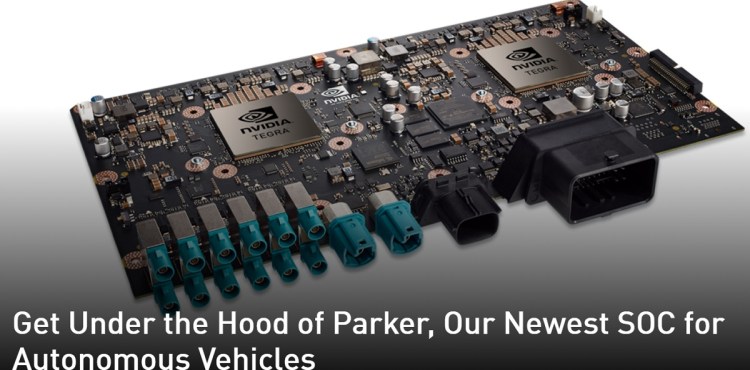If you want to play video games while driving your car, Nvidia has a chip for you.
Just kidding. The graphics chip maker today announced its newest mobile processor, codenamed Parker, which serves as the brains of a platform that could be used in self-driving cars.
Andi Skende, distinguished engineer at Nvidia, spoke about Parker at the Hot Chips conference in Cupertino, Calif., today. Previously, Nvidia revealed its Drive PX 2 platform as a kind of “supercomputer for cars” and digital cockpits. Now, it has taken the wraps off Parker, which is the brains behind the Drive PX 2.
The Drive PX 2 uses two Parker processors and two Pascal-based graphics processing units (GPUs) to power deep-learning applications for self-driving cars. Such cars have to be smart enough to recognize visual obstacles, such as bikers or pedestrians. That’s a very difficult deep learning task.

Above: Nvidia’s Parker chip.
More than 80 carmakers, suppliers, and university research centers around the world are now using the Drive PX 2 system to develop autonomous vehicles. Potential customers include Volvo, which plans to road test Drive PX 2 systems in XC90 SUVs next year.
Parker is part of Nvidia’s Tegra family of processors and includes Nvidia’s next-generation Denver CPU architecture. It delivers up to 1.5 teraflops of performance for deep learning-based self-driving A.I. cockpit systems.
Nvidia also said that Parker delivers 50 to 100 percent higher multi-core CPU performance than other mobile processors. The Parker chips have two 64-bit Denver CPU cores (Denver 2.0) paired with four 64-bit ARM Cortex A57 CPUs. These all work together in a fully coherent heterogeneous multi-processor configuration.
Nvidia says that the Drive PX 2 delivers 24 trillion deep learning operations per second to run the most complex deep learning-based inference algorithms.

Above: Nvidia’s Drive PX 2 is aimed at self-driving cars.
VentureBeat's mission is to be a digital town square for technical decision-makers to gain knowledge about transformative enterprise technology and transact. Learn More

